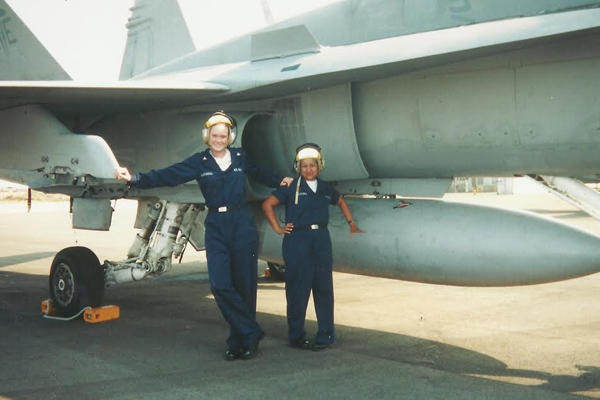Some critics believe the Veterans Preference program is too broad, preventing government agencies from hiring the best talent.
The Senate even voted to limit the preference, though it is unlikely to pass.
Others complain that, because there are relatively few female veterans, the preference negatively affects hiring diversity in federal jobs.
"Women are disproportionately represented, not only in military, but also in senior level positions that are within the federal government," Wanda Killingsworth, president of Federally Employed Women, told The Washington Post. "The veteran's preference has the potential to leave out a segment of highly qualified individuals during the selection process."
The public often seems unaware of female veterans, with many tales of disbelief when a woman says she served.
According to the female veterans' "I SERVE"/"I SERVED" campaign, more than 15% of service members and 9% of the U.S. veteran population are women.
The campaign, backed by Lean in Military Women, Lean in Women Veterans and the Think Broader Foundation, is asking female service members and veterans to submit short video clips stating that they served, to be aired as a public service announcement on Veterans Day in an effort to change the stereotypical male image of American veterans and work toward women's equality.
Interview with Veteran Jennifer Marshall
To better understand a female veteran's take on her service and the importance of highlighting this on Veterans Day, I spoke with veteran and actress Jennifer Marshall.
Marshall spent her high school years in a sleepy one-stoplight town and jumped at the chance to serve her country in the Navy. She served for five years, deploying in support of Operation Iraqi Freedom aboard the USS Theodore Roosevelt.
After honorably separating from the Navy, she became involved in the world of television and film, often playing military and veteran roles. Marshall credits the Navy for her meticulous work ethic, addiction to detail and sharp organizational skills -- all of which have helped her in navigating the choppy waters of Hollywood.
Q: What did you do in the military, and what does it mean to you to have served your country?
A: "I was an aviation storekeeper petty officer second class, or AK2, [a rating] which no longer exists. Basically, I was a logistics specialist but worked on the aviation side in AIMD [the Aircraft Intermediate Maintenance Department]. I supplied the mechanics and technicians with anything and everything they needed to keep the aircraft flying.
"I also ran the Tool Control Program onboard the Roosevelt, which is a huge responsibility. If a tool goes missing, that could mean a downed jet. It is a program that literally means the difference between life and death.
"When I came onboard the USS Theodore Roosevelt, I had the awesome experience of working on the Ship's Security Defense Team and the Repair Locker Fire Team -- both physically tough collateral duties, but incredibly rewarding.
"I grew a lot due to the job diversity I experienced in the Navy. The five years I spent in the military were the highlight of my life and something I look back on with great pride and reverence. I come from a family where generations have served, and I have a deep respect for that tradition."
Q: Have you come across any gender awareness issues in this regard that you'd be willing to share with us?
A: "Both of my collateral duties were dominated by male sailors. When I served on the Roosevelt's Ship's Security Defense Force, there weren't a lot of females. It's not that there wasn't space for females; there was. There just wasn't a lot of interest for one reason or another.
"At that time, the Navy didn't really train us how to shoot, so anyone who shot well was either a GM or MA or liked to shoot in his or her off time. When I went through boot camp [pre-9/11], we only shot five live rounds in training. That's not a typo. Five. The rest of the training was done on a simulator.
"After Sept. 11, things changed and leadership realized that they needed people who knew how to shoot not only pistols, but rifles as well. The political climate was changing, and it wasn't enough to just know how to tie knots and paint the side of the ship. So … my love for shooting was what cemented a place for me on the Ship's Security Defense Force.
"My second collateral duty, the Repair Locker Fire Team, was also very male-dominated due to the heavy gear we had to don and carry. All the gear you have to wear, plus the helmet and the SCBA [self-contained breathing apparatus], can wear you down pretty quickly. For a long time, I was the only female on our locker. At 5'11" and 170, I understood why … It was merely a size and strength issue, not a gender issue.
"I remember one guy who tried to be on the repair locker, but when we went out to train on the hoses, the hose ended up nearly whipping him around the deck. He couldn't have been more than 5'3", 100 pounds soaking wet. After that training session, he decided to focus on the damage control side rather than firefighting. It was a better fit for him. So, like I said before, not a gender issue but more of a size issue.
"With that being said, it was frustrating for me when people would think that I couldn't do either collateral duty simply because I was a female. This vocalization generally came from older sailors, the 'salty dogs' who I honestly felt were still trying to get used to the idea of women serving on warships 10 years after women first came onboard."
Q: Why should people be worried about a lack of gender awareness, especially in regard to the military and veterans?
A: "I see the lack of gender awareness so much more now that I am a veteran. It didn't happen nearly as much when I was in the Navy, and I think that is because I wasn't around the general population on a regular basis. Most of my friends, neighbors and [obviously] co-workers were all Navy, so they didn't think twice about a female serving.
"As a veteran, I have been told countless times, 'You don't look like a veteran' or asked, 'Where did your husband serve?' Questions and statements like these feel demeaning, because I proudly served my country for five years of my life. I don't feel most male veterans would have these things said to them. What does looking 'like a veteran' mean, anyway?
"One day, I finally got so fed up with being told I didn't look like a veteran [ironically after a casting call looking for actors who were actual veterans] that I decided to produce a PSA that would hopefully open people's eyes. After interviewing 15 female veterans from every branch and every era, I ended up with enough footage that we made 10 PSAs instead of the one we had originally planned.
"They are now airing on American Forces Network, and we are currently in talks to get some airtime on network television as well. I want the general public to understand that women serve, too … regardless of what they think a veteran should or does look like.
"I also want Hollywood to take notice. I want to see real depictions of veterans on television and in films. I just don't want to see a 20-something-year-old white male veteran with PTSD. That is how we are currently generalized in the media, and a broader view is necessary.
Q: Does this hold a different weight around Veterans Day, and if so, how?
A: "Definitely. This year, I want to walk into one of the fine places that offers a free meal to vets and actually have someone not be surprised when I tell them I am a veteran, too. I would like to go to the Veterans Day parade in my Navy shirt and not be asked when my husband served. I just want to be perceived in the same light as my brothers.
"Lastly, I must express my appreciation for the men I served alongside and the male veterans I know. Very few of them have ever questioned my service. Now, hopefully we can get the general public onboard to realize people of all races, ethnicities, genders, religions, etc., serve.
"The military is a slice of the population; vets look like everyone else.
Q: Focusing more on your military time, what were some highlights that make you proud to be a veteran? Maybe a short anecdote that stands out as having helped you to become who you are today.
A: "Just thinking back to all the incredible times I had in the Navy makes me smile. Traveling all over the world, the immense responsibilities I had and the lifelong friendships I made have made me the person I am today.
"Remember the old Army slogan, 'Be All That You Can Be?' Well, I feel like the Navy did that for me, in a way. It made me the best version of Jennifer that I could be. Every skill that I learned in the military has helped me in my civilian life. Sure, I may not deal with national stock numbers or tool control anymore, but I use the mental fortitude and discipline I learned every single day."
Q: Do you have anything else you'd like to share?
A: "I would just like to say for anyone who is on the fence about serving; life is 90% attitude and 10% circumstances. In the military, you will sometimes feel like it is 90% circumstances and 10% attitude. It's not. Just keep your eye on the prize, take pride in what you do, work hard and you will be rewarded, whether while in the service or once you separate.
"It sounds like a kindergarten saying, but I always like to say if something needs accomplished, "Vets can do it. Vets can do anything." So go out and do it.
Related Video:
Want to Know More About the Military?
Be sure to get the latest news about the U.S. military, as well as critical info about how to join and all the benefits of service. Subscribe to Military.com and receive customized updates delivered straight to your inbox.















